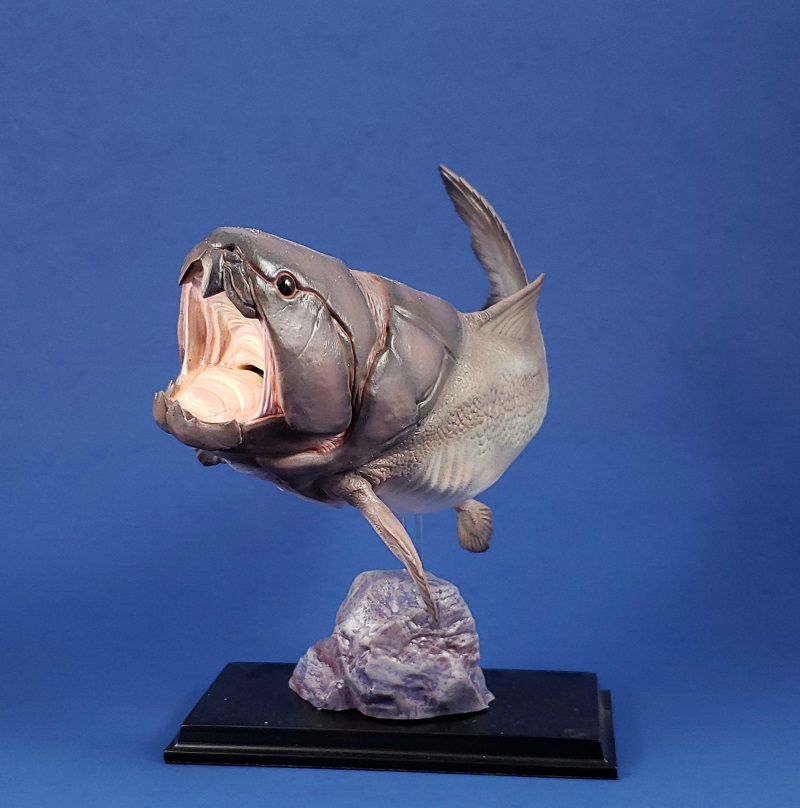
If somebody has heard of just one Paleozoic fish, it’s probably Dunkleosteus, designated yesterday as Ohio’s official state fossil fish! Toy companies have made more than a dozen different versions over the years, and several higher-end models exist as well. Earlier this year, a Thai studio called Like Hobby/ThinkArt released one of the latter. The prototype was sculpted digitally, and the final model is a hollow resin cast of a hand-finished 3D print. You can buy this Dunkleosteus as an unpainted kit or as a finished model. I opted for the finished version, which was available for around $100 US. It comes with a simple, stately base, to which it is mounted by an acrylic rod inserted into a hole in the belly. It’s a very striking piece of work, although from a paleobiological perspective, it has quite a few issues.

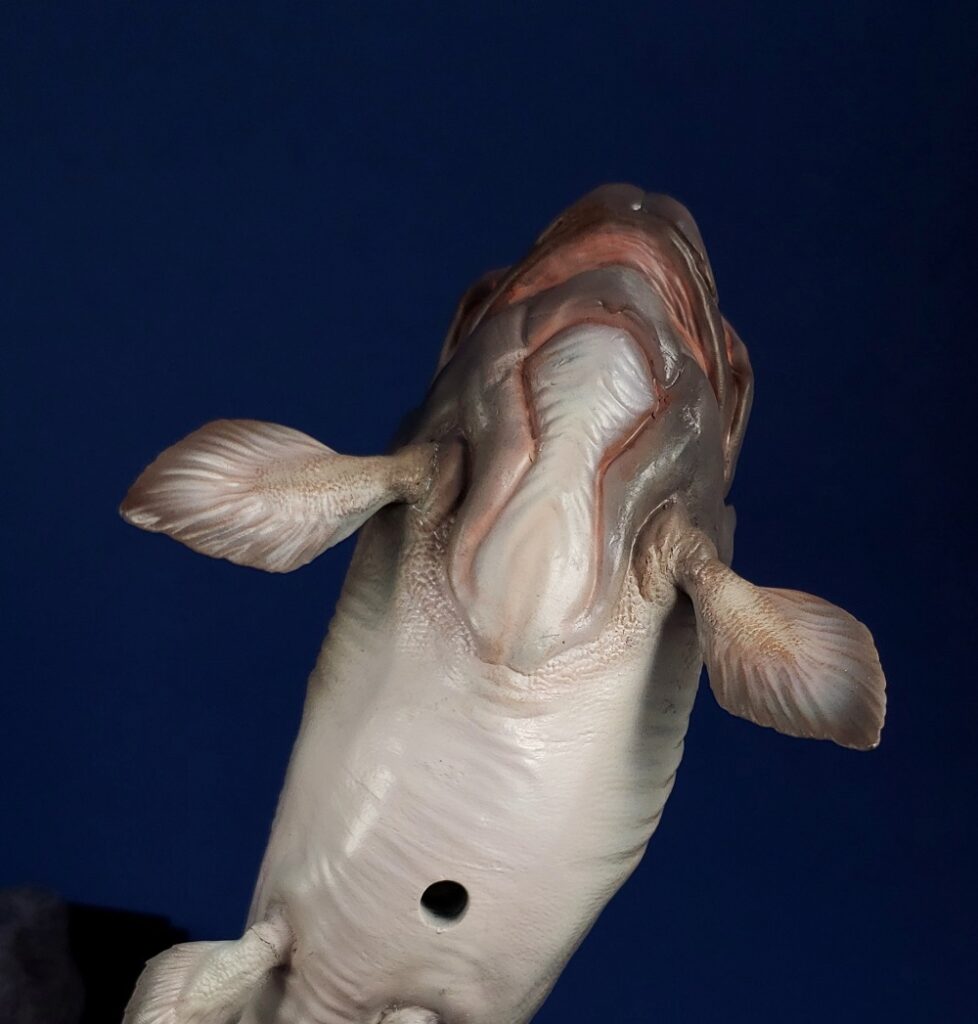
Let’s start with the obvious: this is an attractive, highly detailed model. The pose is interesting, with the open mouth, the posture of the fins, and the bend in the tail all implying a twisting strike on maneuverable prey, such as the early chondrichthyan Cladoselache or smaller arthrodire placoderms like Heintzichthys or Gymnotrachelus. This kind of pose is a common presentation for the Devonian’s most famous predator, and why shouldn’t it be? However, as we’ll see, some of the things that make it look lifelike also make it wildly inaccurate.
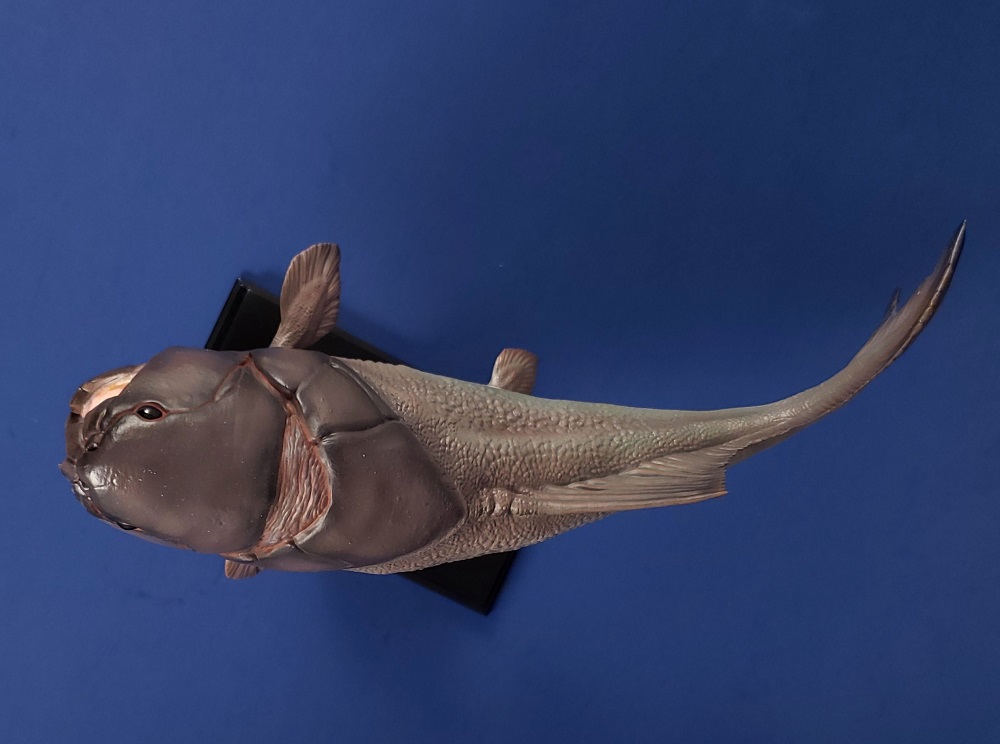
Biomechanically, the head works pretty well. The suborbital plate (the large armor segment beneath the eye) is flared, with its lower edge swinging away from the underlying gills during the strike. This detail is often overlooked, and its omission is one reason that Dunkleosteus models with articulated jaws always look a little bit wrong. There is some effort to incorporate the dermal armor into the skin, such as the membranes at the corners of the mouth, but there are altogether too many joints visible. Even on a modern fish, you can certainly see some individual parts of the dermal skeleton while the fish is alive, like the opercle and often the maxilla, but others are not easy to discern with the skin intact. There is no reason to think that Dunkleosteus was any different, and perhaps disappointingly for those who like their prehistory monstrous, there would have probably have been something resembling lips at least partially obscuring those wicked blades of bone at the margins of the mouth. There are many problems with CollectA’s Dunkleosteus, but it does a good job in this respect. Early prototypes of the ThinkArt model showed the sclerotic ring as an external feature, although the final version places it inside the eyeball where it belongs. The designers deserve credit for the correction.
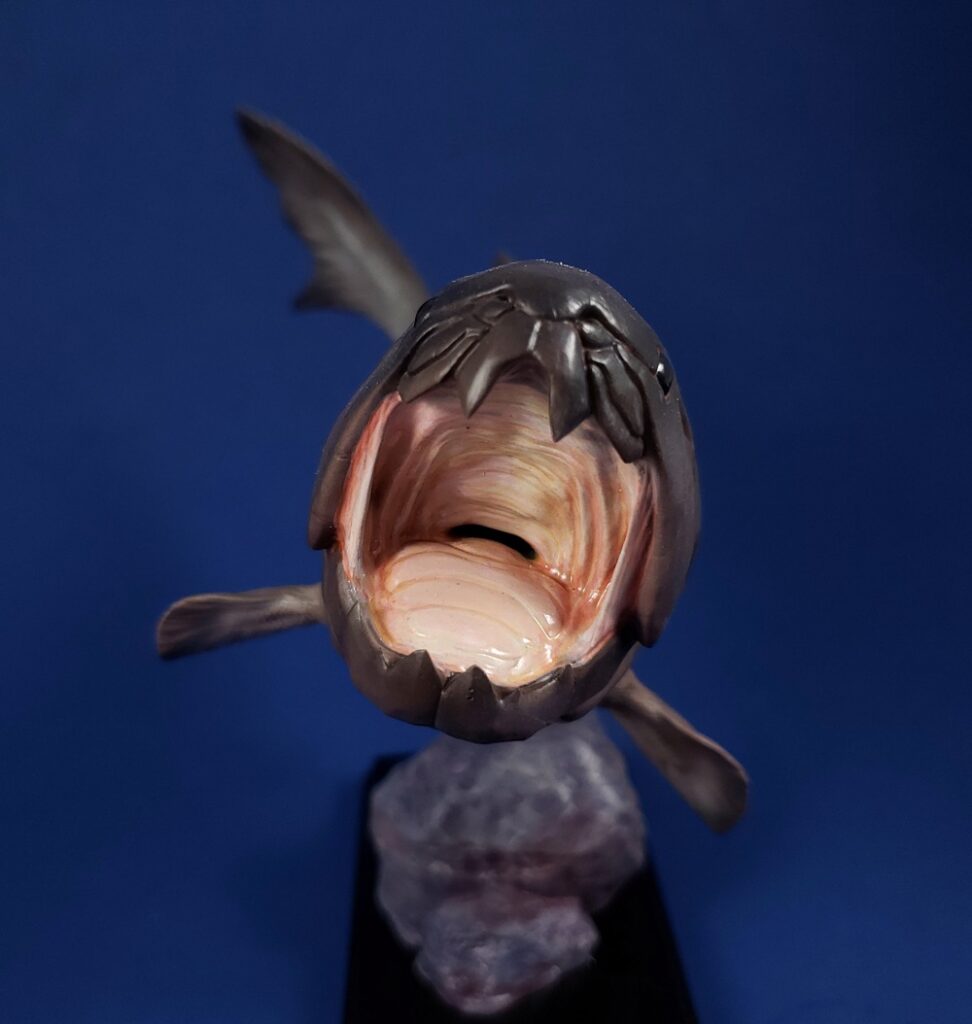
The pectoral and pelvic fins are thickened at their bases with rays spreading out from there. This is an unlikely morphology, and was probably chosen because it looks vaguely prehistoric (see coelacanths, lungfishes, and Tiktaalik). The dorsal and anal fin have an interesting morphology that I don’t recall seeing in placoderm models before this one: there are long, collapsible bony rays supporting them, and they’re folded back for a burst of speed. If you’ve ever watched a perch or a sunfish flee from a hand on the aquarium glass or a rock tossed in a lake, you’ve probably seen them fold down their fins this way. In paintings of largemouth bass, and in this statue, the folded-down leading edges of the fins convey a sense of motion and urgency. Unfortunately, big arthrodires could not fold their fins. Their fins were composed of ceratotrichia, which are pliable, interconnected rods of protein that form fins into a single sheet. A sunfish folding down its dorsal fin relies on inflexible spiny rays, connected to each other only by a membrane, and controlled individually by bones called pterygiophores and a series of muscles inserting on the base of each ray. Arthrodires emphatically did not have these features. The tail looks good if you squint, being vaguely sharklike in silhouette, but the underlying anatomy is as shaky as the other fins. Fossils of arthrodire ceratotrichia suggest that their fins looked very much like shark fins instead, not foldable like a perch, and not lobed like a coelacanth.
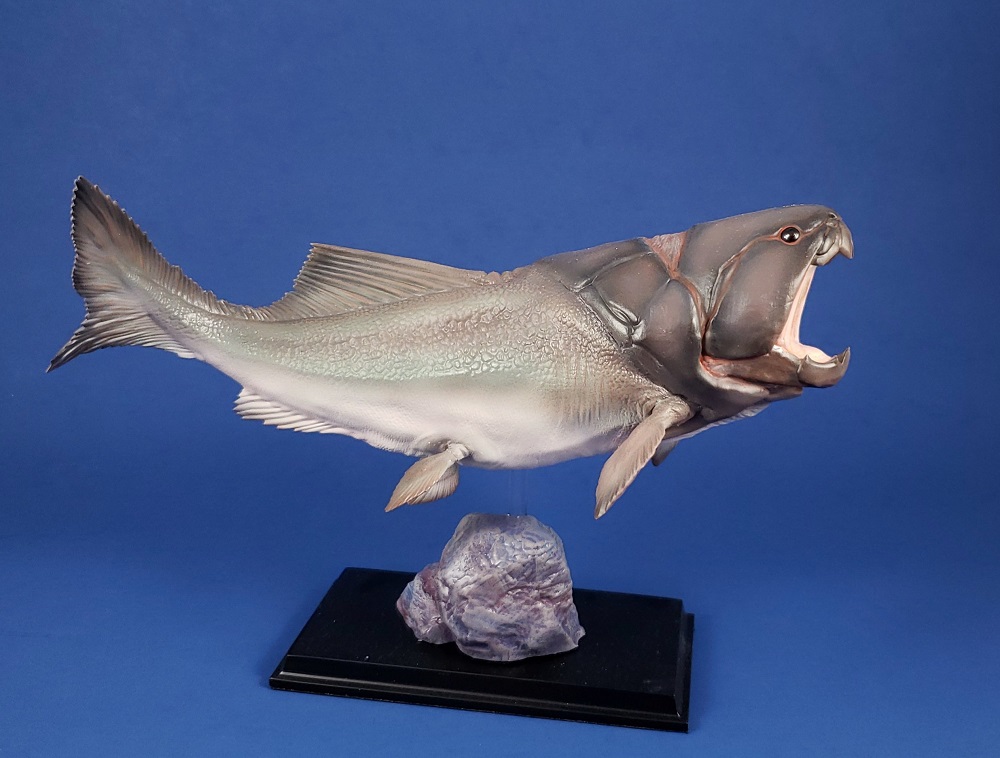
The flanks of the model have a fair amount of intricate detail. There are ridges that I believe are meant to suggest ribs directly behind the pectoral fins. The dorsolateral surfaces of the body have a pebbly texture. We don’t have skin impressions for Dunkleosteus, but it’s still possible based on biological first principles to say that these textures are extremely unlikely. They would create unnecessary drag, the last thing a big marine predator wants. It’s common for companies to give their marine models excessive texture, from the wrinkles on PNSO’s Ophthalmosaurus and Otodus, to the ridiculous osteoderms on the Dunkleosteus figures by CollectA and Schleich. It may be that many collectors, bamboozled by a glut of over-textured models and toys, would skip over realistically textured–that is, smooth–figures of fish and marine reptiles. It may be that companies merely fear that collectors would do so. Either way, I wish more companies would avoid including extraneous detail for its own sake. Favorite Co managed to avoid the texture pitfall with their Dunkleosteus, still the best on the market in my estimation.
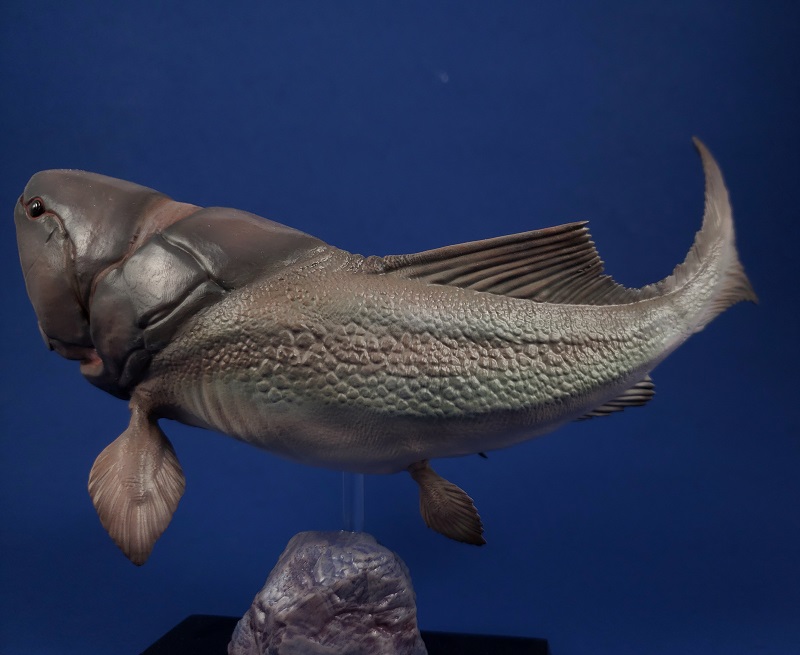
The ThinkArt Dunkleosteus is roughly 24 cm long measured along the curves, with a head width of just under 6 cm, making it about 1:20-1:30 scale. If you’re into hyper-detailed figurines with good shelf presence, you might really enjoy it. If you like figurines that get as close as possible to what animals actually looked like, it’s probably not for you. It is definitely not suitable for young children. Although I am loath to link to Facebook for any reason, as far as I can tell it’s the only way to get this model if you want one: https://www.facebook.com/likehobbies/about. My copy came with the two right fins broken off, but I was able to repair it. When I notified the ThinkArt team, they offered prompt and courteous customer service and I was happy with the outcome.
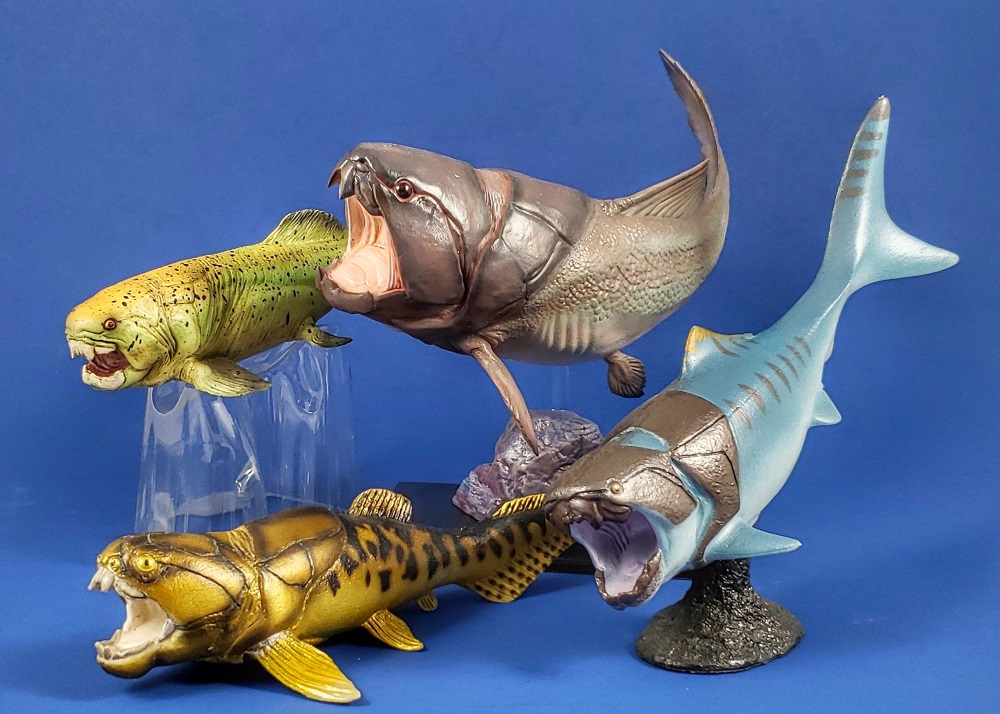
Dunkleosteus figures by Mojö, ThinkArt, Favorite Co, and Safari Ltd
Disclaimer: links to Ebay and Amazon on the DinoToyBlog are affiliate links, so we make a small commission if you use them. Thanks for supporting us!




Awesome and impressive model for sure. It’s always fun to see the many different versions available. Great review.
Another nice Dunkey! I am sticking with the golden oldie (literally), Safari 😀
That one’s also very good, although it is outdated in a couple of ways mainly related to the fins. It does an excellent job of depicting lips/skin and the angle of the plates during feeding.
I recognize this model from one of your DTF posts and I can understand that you bought this for review. I think your research is well-done, after all, you do have knowledge of the anatomy of fish. I’m not really going to get this, but I am currently working on a review for the Mojo Dunkleosteus. Is there anything that I should acknowledge when I talk about accuracy? Because that could help with my review. Anyway, a great review as always.
Yes, I hope people will forgive me for recycling a couple of photos from my collection thread! Thanks for the kind words.
Were you planning to submit a review to the DTB of the Mojo Dunkleosteus, or were you planning to review it elsewhere? I ask because I’m also working on one (for “Fishmas”) and wouldn’t want to duplicate our efforts.
I am still working on it and I want it to be on the blog since its going to be my second review. I believe I’m over halfway through it, and don’t want to stop. I have a bit of information on the figure left to work on, the accuracy section, and my final words left. I also plan on doing five individual photos.